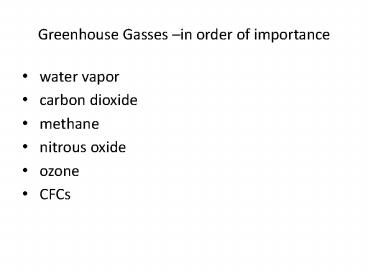Greenhouse Gasses - PowerPoint PPT Presentation
Title:
Greenhouse Gasses
Description:
Greenhouse Gasses in order of importance water vapor carbon dioxide methane nitrous oxide ozone CFCs – PowerPoint PPT presentation
Number of Views:175
Avg rating:3.0/5.0
Title: Greenhouse Gasses
1
Greenhouse Gasses in order of importance
- water vapor
- carbon dioxide
- methane
- nitrous oxide
- ozone
- CFCs
2
Changes in greenhouse gas concentrations
- Historical variations can be tracked via analysis
of ice cores - Ice core - a core sample (a cylindrical section
of a naturally occurring medium consistent enough
to hold a layered structure) from the
accumulation of snow and ice over many years that
have re-crystallized and have trapped air bubbles
from previous time periods. - The composition of these ice cores provides a
picture of the climate at the time. - Record for over 800,000 years
Gas Preindustrial Level
Current Level Increase since 1750 Carbon
dioxide 280 ppm 387ppm
104 ppm Methane
700 ppb 1,745 ppb
1,045 ppb Nitrous oxide 270 ppb
314 ppb 44 ppb CFC-12
0
533 ppt 533 ppt
3
What do the ice cores tell us?
- Natural variations occur in the greenhouse gas
concentrations
4
Post industrial revolution
5
Man made sources of greenhouse gasses
- Also called Anthropogenic, which designates an
effect or object resulting from human activity - burning of fossil fuels and deforestation
leading to higher carbon dioxide concentrations. - Account for one third of total anthropogenic CO2
emissions. - livestock enteric fermentation and manure
management, paddy rice farming, land use and
wetland changes, pipeline losses, and covered
vented landfill emissions leading to higher
methane atmospheric concentrations. Many of the
newer style fully vented septic systems that
enhance and target the fermentation process also
are sources of atmospheric methane. - use of chlorofluorocarbons (CFCs) in
refrigeration systems, and use of CFCs and halons
in fire suppression systems and manufacturing
processes. - agricultural activities, including the use of
fertilizers, that lead to higher nitrous oxide
(N2O) concentrations.
6
What are we seeing?
- Since 1860-1900, global surface temperatures have
increased by 1.35 F - Urban heat island effect only accounts for 0.02 C
rise - Since 1979 land T have increased twice as fast as
ocean temperatures - Temperatures on the lower troposphere have have
increased by 0.62 between 1979 and 2000.
7
Hold on, could it be the sun?
- No overall increase in solar brightness in over
1000 years - Solar cycles do cause small variations in
brightness, but not enough to account for what
has been seen - No its not the sun
8
Feedback-making the problem worse (or better)
- Positive feedback-when the warming induces
further warming - Negative feedback when the warming induces a
cooling
9
Sources of Feed back
- Positive
- Water vapor
- Clouds
- Ice albedo
- Arctic methane release
- Reduced carbon dioxide absorption in the oceans
- Negative
- Lapse rate
10
Negative feedback
- Lapse Rate
- Increased heating means increased IR emission
- Global warming reduces the rate of temperature
decrease with height, which means more long
wavelength radiation will be emitted by the upper
atmosphere - This will weaken the greenhouse effect
11
Positive feedback
- Water vapor
- Warming increases the amount of water vapor in
the atmosphere, which increases the warming since
water vapor is also a greenhouse gas - Clouds
- Act as a blanket, reflect IR radiation downward
toward the surface - Ice albedo
- Melting ice reveals land and water, both reflect
less light than ice-more warmth is absorbed
increasing warming - Arctic methane release
- Warming releases sources of carbon dioxide
- Reduce carbon dioxide absorption in oceans
- Warm waters favor the growth of plankton rather
than diatoms-diatoms are more efficient carbon
dioxide absorbers
12
Global dimming
- An effect that has been counteracting some of
global warming from about 1960 forward - Aerosols produced by volcanoes and pollutants
such as sulfur dioxide reflect incoming sunlight - Soot suspended in the atmosphere, it can absorb
solar radiation and heat the atmosphere, but cool
the surface
13
What are we seeing
- Besides the increases in Temperature
- Worlds glaciers are melting
- Arctic sea ice is reducing in both extent ( 9
reduction in area per decade) and thickness
(15-40 in thickness in the last 30 years) - Ocean levels are rising-both due to melting of
Antarctic ice and thermal expansion of sea water - Longer growing seasons
- Thawing of permafrost in Alaska
- Coral reef bleaching-whitening of reefs due to
increased temperature - Earlier plant flowering
- Earlier bird arrivals
- Shifting of animal ranges poleward
- More frequent EL Nino-warming of the Pacific
ocean surface temperatures-causes changes in
local weather patterns
14
Global warming-the debate
- The fact that the Earth is warming is not a
matter of debate, the evidence is clear - The fact that global carbon dioxide levels have
increased is also clear - The debate centers around how much of it is
caused by human involvement vs a natural cycle - Think about it in terms of the steps in the
scientific method
15
Global warming in the context of the scientific
method
- Observations-Earths temperature is warming
- Hypothesis-due to a man-made increase in green
house gases - Testing the hypothesis-many scientists hold
different views and interpret data differently,
but the consensus is that it is due to increases
in greenhouse gasses from man made sources. - Until the data is incontrovertible, there will
always be naysayers. Thats ok, they keep us
honest and push the method forward-as long as
they are within the realm of the scientific
method - Lots of examples like this in modern science
(evolution, big bang, cosmological
interpretations of galaxy redshifts)































